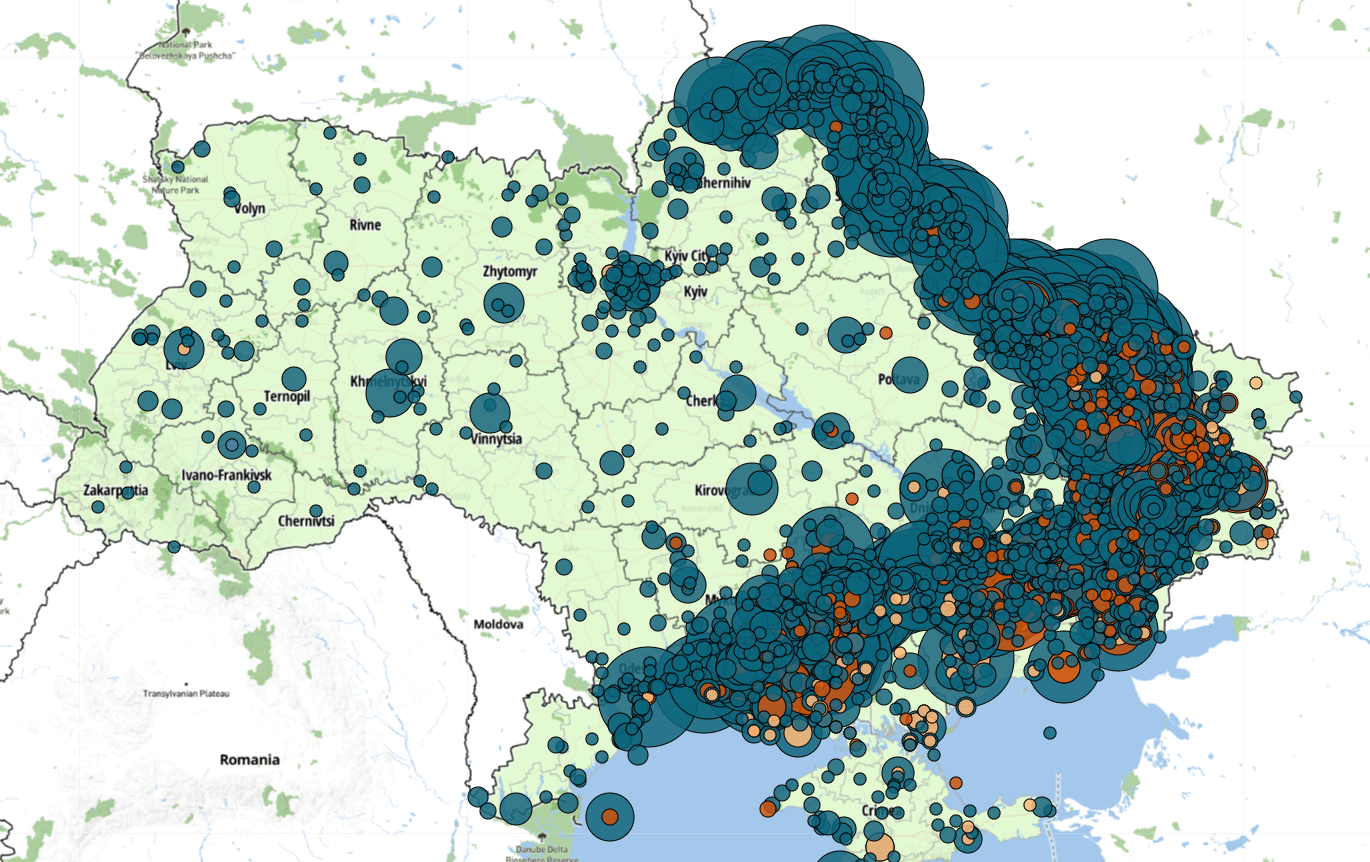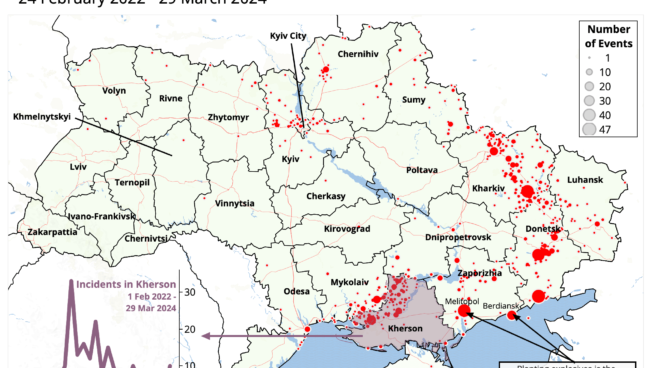Last updated: 11 June 2025
Amid the ongoing war in Ukraine, this aerial photograph shows the destruction in the village of Bohorodychne in the Donetsk region on 27 January 2024. Photo by Roman Pilipey/AFP via Getty Images
ACLED’s Ukraine Conflict Monitor provides near real-time information on the ongoing war, including an interactive map of the latest data from the start of Russia’s invasion, a curated data file, and weekly situation updates. It is designed to help researchers, policymakers, media, and the wider public track key conflict developments in Ukraine. It is released every Wednesday, with data covering events from Saturday to Friday of the preceding week and providing updates to past events as new or better information becomes available.
Ukraine war situation update
31 May – 6 June 2025
Key trends
- In the Donetsk region, Russian forces made territorial gains in the area of Pokrovsk, north of Velyka Nososilka, south of Kramatorsk, and north of Lyman, occupying at least four settlements.
- Russian forces seized five settlements near the international border north of Sumy city and advanced north of Kupiansk in the Kharkiv region.
- ACLED records at least 40 Russian long-range missile and drone strikes, including in Kyiv city and the Kyiv region, as well as in the western regions of Lviv, Volyn, Khmelnytskyi, and Ternopil.
- Russian shelling, missiles, aerial bombs, and drones killed at least 46 civilians in the Chernihiv, Dnipropetrovsk, Donetsk, Kharkiv, Kherson, Sumy, Volyn, and Zaporizhia regions and Kyiv city.
Key events
- 2 Jun. | Luhansk – Russian forces transport 150 Ukrainian children from occupied Rovenky to a camp in Russia
- 3 Jun. | Sumy – Russian shelling kills four civilians and wounds 28 in Sumy city
- 6 Jun. | Kyiv city – Russian drones and missiles kill three emergency workers and wound over 30 people
Spotlight: Ukraine scales up attacks on Russian airbases and supply routes
On 1 June, 117 Ukrainian drones carried out an unprecedented series of simultaneous attacks on multiple stationary military aircraft at airfields in Russia’s Bryansk, Ryazan, Ivanovo, Murmansk, Irkutsk, and Amur regions. The Ukrainian military claimed the drones hit a total of 41 aircraft — over a third of all Russian strategic cruise missile carriers.1Kateryna Hodunova, “Ukraine confirms 41 Russian aircraft including bombers hit during Operation Spiderweb,” The Kyiv Independent, 3 June 2025 Available visual evidence suggests around a dozen bomber jets may have been destroyed.2Laura Gozzi and BBC Verify, “How Ukraine carried out daring ‘Spider Web’ attack on Russian bombers,” BBC, 2 June 2025; Sonya Bandouil, “34% of Russian strategic Russian bombers at main airfields damaged in Ukrainian drone operation, SBU reports,” The Kyiv Independent, 1 June 2025 For the attacks in the remote regions of Murmansk, Irkutsk, and Amur — the latter two hitherto beyond the reach of the Ukrainian military — Ukrainian special services smuggled drones into Russia, which were unknowingly transported by truck drivers.3Ekaterina Venkina, “Zelensky on operation ‘Spider Web’: Drivers did not know about the houses for UAVs,” Deutsche Welle, 7 June 2025 (Russian) The truck transporting drones in the Amur region exploded en route to the Ukrainka airfield. Ukraine also attempted several other attacks on military airfields during the week, successfully hitting at least one in the Voronezh region on 2 June.
Meanwhile, a series of explosions hit railway infrastructure in Russia and occupied parts of Ukraine. The deadliest one took place on 31 May, when an explosion in the Bryansk region caused a bridge to collapse on a passenger train, killing seven civilians and wounding 127 others. Four more explosions damaging civilian or service trains or railway tracks were recorded in the Bryansk, Kursk, Belgorod, and Voronezh regions throughout the week, in addition to a Russian military train that was blown up in the occupied part of the Zaporizhia region. On 3 June, Ukraine attacked the Kerch bridge for the third time since 2022 using underwater explosives that damaged the base of the bridge. The bridge connects occupied Crimea with Russia.4Peter Beaumont and Artem Mazhulin, “Ukraine hits bridge linking Crimea to Russia with underwater explosives,” The Guardian, 3 June 2025
Russia accused Ukrainian military intelligence of being behind the bombings in Russia;5Meduza, “Russian authorities blame bridge collapses on ‘terrorists’ working for ‘Kyiv regime,’” 3 June 2025; Meduza, “‘Evidence indicates that all terrorist attacks were organized by the Ukrainian special services.’ Bastrykin on the blowing up of bridges in the Kursk and Bryansk regions,” 4 June 2025 (Russian) Ukraine claimed responsibility for the Kerch bridge and Zaporizhia explosions but not for the rest of the incidents.6Facebook @Main Directorate of Intelligence in Ukraine, 1 June 2025Main Directorate of Intelligence in Ukraine, 1 June 2025 (Ukrainian); Martin Fornusek, “Russia’s Crimean Bridge rocked by explosions, Ukraine’s SBU claims responsibility,” The Kyiv Independent, 3 June 2025 Ukrainian military intelligence and pro-Ukrainian partisan groups have frequently targeted Russian railway infrastructure with explosions or arson attacks. ACLED records over 200 such events since Russia’s all-out invasion of Ukraine in early 2022, of which over 80% occurred in Russia proper.
Explore the ACLED Conflict Exposure tool to assess the numbers of people affected by armed violence, disaggregated by locations, time period, and actors involved.
Ukraine Conflict: Interactive Map
This interactive map includes political violence events in Ukraine since the start of the Russian invasion on 24 February 2022.
Date and subset filters
By default, the map displays data for the most recent week. Use the date filters to change the date range in view.
Use the subset filters to analyze trends in more detail.
Changing view
By default, the map is set to event view, which uses scaled circles to show events at a given location. Click on a region in Ukraine to zoom in for a more detailed view. Hovering over a region will give a count of events within its borders.
Changing to region (oblast) view will switch the map to a choropleth, giving an overview of event density per region. This will also disable the zoom function.
Events in Russia
While in event view, use the ‘Events in Russia’ toggle to show or hide conflict-related events in Russia. Conflict-related events are identified as follows:
- All events with the ‘Battles’ or ‘Explosions/remote violence’ event type.
- Events with the ‘Violence against civilians’ event type, where the actor is:
- Ukrainian or Russian military
- Russian border guards
- Pro-Ukrainian Russian militias
Attacks on Ukranian infrastructure
ACLED uses four automatically generated infrastructure tags when coding events that occur in Ukraine, each covering a vital sector that focuses on civilian infrastructure: energy, health, education, and residential infrastructure.
For more information, read our methodology explainer.
Event counts and civilian fatalities
The box in the bottom right hand corner displays event counts in total, disaggregated by event type, and filtered by date or subset according to the options already selected.
It also shows a conservative estimate of civilian fatalities, limited to events where civilians are targeted directly. Military casualties are not represented on the map as they are largely unverifiable.
For more information on how ACLED codes fatalities, read our methodology explainer.
Curated Data
This file contains all political violence events, demonstration events, and strategic developments recorded in Ukraine and the Black Sea from the beginning of ACLED coverage in 2018 to the present.
For an overview, see our interactive dashboard.

Ukraine & the Black Sea ( 06 June 2025 )
Attacks on Ukranian infrastructure
ACLED uses four automatically generated infrastructure tags when coding events that occur in Ukraine, each covering a vital sector that focuses on civilian infrastructure: energy, health, education, and residential infrastructure. This file contains all events featuring one or more of these tags.
For more information, read our methodology note.
Sign up for Ukraine Conflict Monitor updates
Information & Analysis
For additional information on the conflict in Ukraine, check our analysis of political violence trends from the start of ACLED coverage in 2018.












